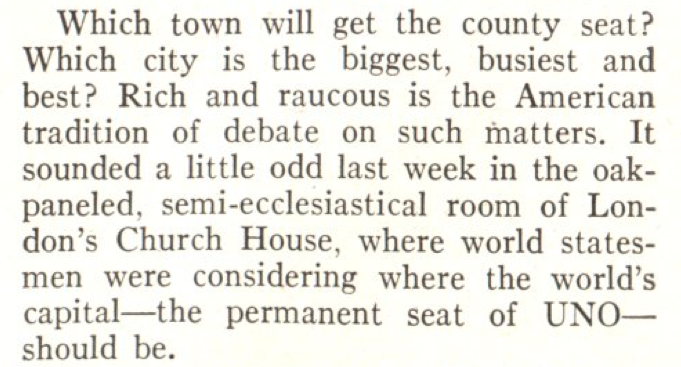
Representatives from around the world are now gathering in New York City for the 69th session of the United Nations General Assembly. A vast cadre of diplomats, staff and heads of state have descended on the Big Apple — ensuring a nightmare for daily commuters. But, though that traffic jam is now a dependable annual event, New York City wasn’t the obvious choice for the United Nations headquarters.
In the wake of the 1945 conference establishing the modern day United Nations — which took place in San Francisco — a committee was set up to find the best spot for what would essentially become the world’s capital. A look back into TIME’s coverage of that period shows that the competition to host the U.N. was wide open, though one thing was clear: New York City, where the UN would be overshadowed by “Wall Street, etc…” as one TIME story put it, was no good.
Philadelphia made a strong case for itself when delegates visited to check out potential sites in 1946, TIME reported:
When the time for on-the-spot inspection came, the spirit of brotherly love was almost overpowering. There was a cocktail party for them in the home of Mr. and Mrs. Kenneth Day, who would be evicted if [one of the potential locations] were chosen. Mr. and Mrs. Day thought that would be a fine idea.
…Philadelphia’s hosts never missed a bet. There was a concert by the famed Philadelphia Orchestra, a luncheon at the Art Museum (under pictures by Matisse, Gauguin and Reynolds). In a helicopter provided for the delegates, Holland’s Jan de Ranitz and Dr. M. P. M. van Karnebeek plopped down near Philadelphia for a hearty greeting by a local farmer & family.
But, still, even Philadelphia was considered to be too close to New York and Washington, D.C.
Chicago, San Francisco, Atlantic City and Boston were among the other locales lobbying to become the permanent headquarters. One unlikely contender, the Black Hills region of South Dakota, made the rational argument that it was far from the reach of an atomic bomb, unlike the coastal cities.
“In the Black Hills there are no military objectives, and the gentlemen who are striving for the peace of the world can live at peace while the atomic bombs are falling,” Paul Bellamy, a businessman representing the Black Hills, told an assembly of the U.N., which was temporarily based in London, according to a TIME story from December 1945.
“It was no part of Bellamy’s job, or of the booster tradition,” the author noted, “to ask what the gentlemen would be doing at that point.”
Ultimately, Bellamy’s urgings were for naught. Despite the organizers’ original misgivings, real-estate concerns ended up carrying more weight than atomic ones: New York City received the boost it needed when philanthropist John D. Rockefeller Jr. gifted a parcel of Manhattan land to the U.N.
Read a 1952 cover story about the building of the current United Nations headquarters: Cheops’ Architect
More Must-Reads from TIME
- Cybersecurity Experts Are Sounding the Alarm on DOGE
- Meet the 2025 Women of the Year
- The Harsh Truth About Disability Inclusion
- Why Do More Young Adults Have Cancer?
- Colman Domingo Leads With Radical Love
- How to Get Better at Doing Things Alone
- Michelle Zauner Stares Down the Darkness
Write to Noah Rayman at noah.rayman@time.com